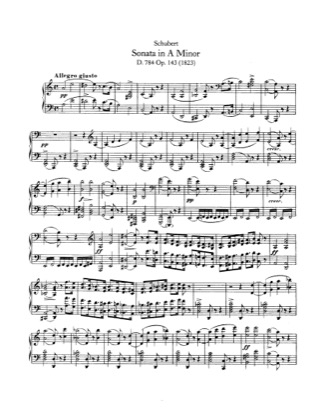Fantaisie-Impromptu in c sharp Minor, Op.66
Chopin2,324

This is free piano sheet music for Piano Sonata in A minor, D.784, Schubert provided by allpianoscores.com
The Piano Sonata No. 14 in A minor, D. 784 by Franz Schubert is a sonata for solo piano, posthumously published as Op. 143. Schubert composed the work in 1823, the first sonata written after his illness the year before. It is extremely demanding technically and emotionally, requiring a virtuoso technique to be played properly. This piece, similar to several other works by Franz Schubert was neglected during the time of its publishing for Schubert had broken most of the rules of the classical era's compositional style and pushed this piece to its limits by attempting to reach out towards the romantic side of music. The work is in three movements: Allegro giusto Andante in F major Allegro vivace The virtuosic work takes approximately 20 minutes to perform. 25 Minutes if one choose to play the repeat in the first movement. The piece is arguably Schuberts darkest composition on the piano, capturing and displaying the dark side of his life. This can be heard in the opening theme, which is simple, haunting, and ghostly, seemingly devoid of all emotion. The slow-march style and heavy chords of the main theme anticipates Mahler and even shows hints of Rachmaninoff with its inconspicuous yet moving melody. The three movements of the Piano Sonata in A minor, D. 784, show an almost total disregard for the conventions of Classical pianism. Harmonic figuration and melodic ornamentation as it was known to Haydn, Mozart, or even Beethoven are absent, and in their place is a kind of sparse, basic texture that has often been called "unpianistic. " In this piece, Schubert presumably began experimenting with darker music, tones and unconventional harmonic accompaniment, albeit not compromising his personal style and lyrical ability. Through it he conveyed his hardships and woes, his awareness of his failing health, and the prospect of the macabre. It is a reflection of Schubert's bleak outlook of his sufferable life at that time. The first movement is built out of large blocks of sound, often in bare octaves, that occasionally burst forth into aggressive dotted gestures or, with the arrival of the pianissimo second subject in E major, bell-like quarter notes. The rhythm throughout the movement can only be described as hyper-repetitive; behind this apparently static screen (an impression aided by the profusion of long-sustained pedal-points), however, is a very potent fury. The following Andante is, by comparison, warm and engaging; its lovely arch-shaped melody is eventually thrown into the left hand and shadowed, two octaves above, by the triplets of the right hand. The finale is a wild thing composed mostly in running triplets; there is a constant kinetic energy, made all the more palpable by furious imitation between the hands. A more melodious idea occasionally breaks in to dispel this demonic undercurrent (the movement is a kind of rondo). Leo Black has commented that Schubert made use of the same rhythm of the 1818 song "An den Mond, in einer Herbstnacht" in this sonata's slow movement. In addition, Black has noted that Schubert made a musical allusion in the slow movement of the Arpeggione Sonata to the D. 784 sonata.
